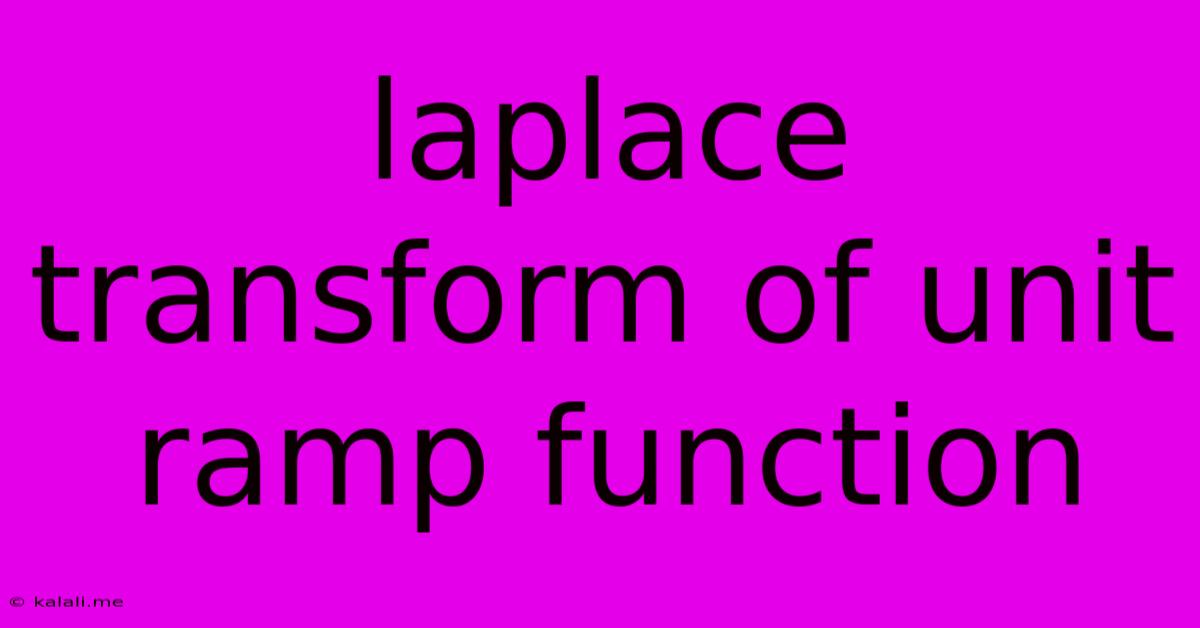Laplace Transform Of Unit Ramp Function
Kalali
Jun 15, 2025 · 2 min read

Table of Contents
Laplace Transform of the Unit Ramp Function: A Comprehensive Guide
The Laplace transform is a powerful tool in engineering and mathematics, enabling the transformation of differential equations into algebraic equations, simplifying analysis and solving complex problems. Understanding the Laplace transform of common functions is crucial for mastering this technique. This article provides a comprehensive guide to understanding and calculating the Laplace transform of the unit ramp function.
What is the Unit Ramp Function?
The unit ramp function, often denoted as r(t) or u<sub>r</sub>(t), is a fundamental function in signal processing and control systems. It's defined as:
r(t) = 0, t < 0
r(t) = t, t ≥ 0
Essentially, it's a function that starts at 0 and increases linearly with time. Its slope is 1, hence the term "unit" ramp. Understanding its characteristics is key to grasping its Laplace transform.
Deriving the Laplace Transform
The Laplace transform of a function f(t) is defined as:
L{f(t)} = F(s) = ∫₀^∞ e^(-st) f(t) dt
where s is a complex variable. Applying this definition to the unit ramp function:
L{r(t)} = ∫₀^∞ e^(-st) t dt
This integral can be solved using integration by parts. Let:
u = t => du = dt dv = e^(-st) dt => v = -e^(-st) / s
Applying integration by parts:
∫₀^∞ e^(-st) t dt = [-te^(-st) / s]₀^∞ + ∫₀^∞ e^(-st) / s dt
Evaluating the limits:
[-te^(-st) / s]₀^∞ = 0 (assuming Re(s) > 0)
The remaining integral is:
∫₀^∞ e^(-st) / s dt = [-e^(-st) / s²]₀^∞ = 1 / s²
Therefore, the Laplace transform of the unit ramp function is:
L{r(t)} = 1 / s²
This result holds true for Re(s) > 0, ensuring the integral converges.
Applications and Significance
The simplicity of the Laplace transform of the unit ramp function (1/s²) makes it incredibly useful in various applications:
-
Control Systems: Analyzing and designing control systems often involves ramp inputs, representing gradual changes in desired outputs. The Laplace transform facilitates the analysis of the system's response to such inputs.
-
Signal Processing: The unit ramp function appears in many signal models. Its Laplace transform allows for frequency domain analysis and filtering design.
-
Solving Differential Equations: When a differential equation involves a ramp function as an input, the Laplace transform converts the equation into an algebraic equation, greatly simplifying the solution process.
Understanding the Inverse Transform
The inverse Laplace transform of 1/s² is the unit ramp function, confirming the validity of our derivation. Understanding both the forward and inverse transforms is crucial for practical applications.
Conclusion
The Laplace transform of the unit ramp function is a fundamental result with wide-ranging applications in various fields. Its derivation, through integration by parts, and its practical implications highlight the power and utility of the Laplace transform in solving complex engineering and mathematical problems. Mastering this concept is a cornerstone of understanding advanced signal processing and control systems. This clear understanding will help you effectively tackle more complicated transforms and system analyses in the future.
Latest Posts
Latest Posts
-
Which Of The Following Is Not A Property Of Metal
Jun 15, 2025
-
What Is The Difference Between Annuity And Perpetuity
Jun 15, 2025
-
Group Of Baboons Is Called Collective Noun
Jun 15, 2025
-
Which Of The Following Is Not Element
Jun 15, 2025
-
Similarity Due To Convergent Evolution Is Called
Jun 15, 2025
Related Post
Thank you for visiting our website which covers about Laplace Transform Of Unit Ramp Function . We hope the information provided has been useful to you. Feel free to contact us if you have any questions or need further assistance. See you next time and don't miss to bookmark.